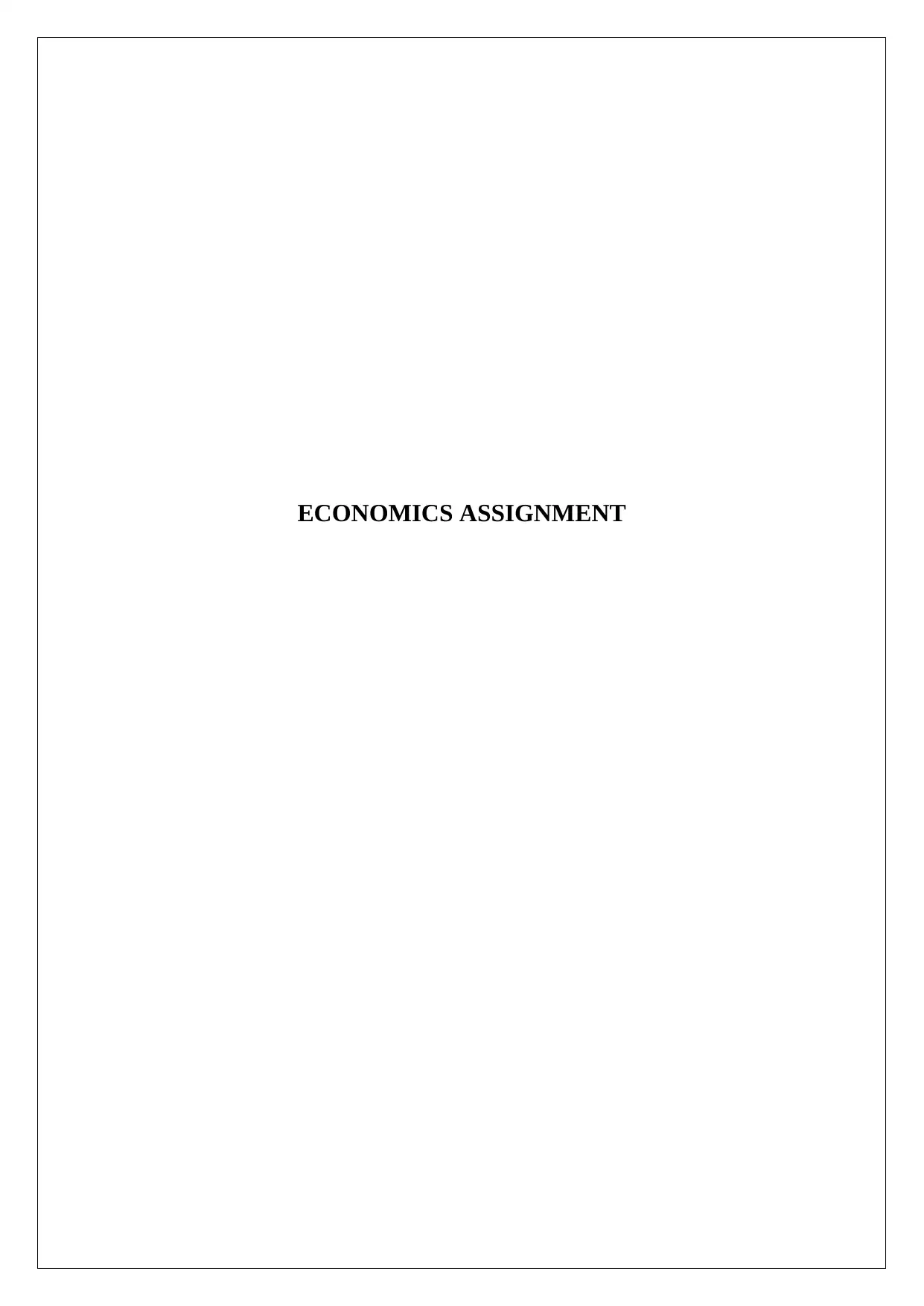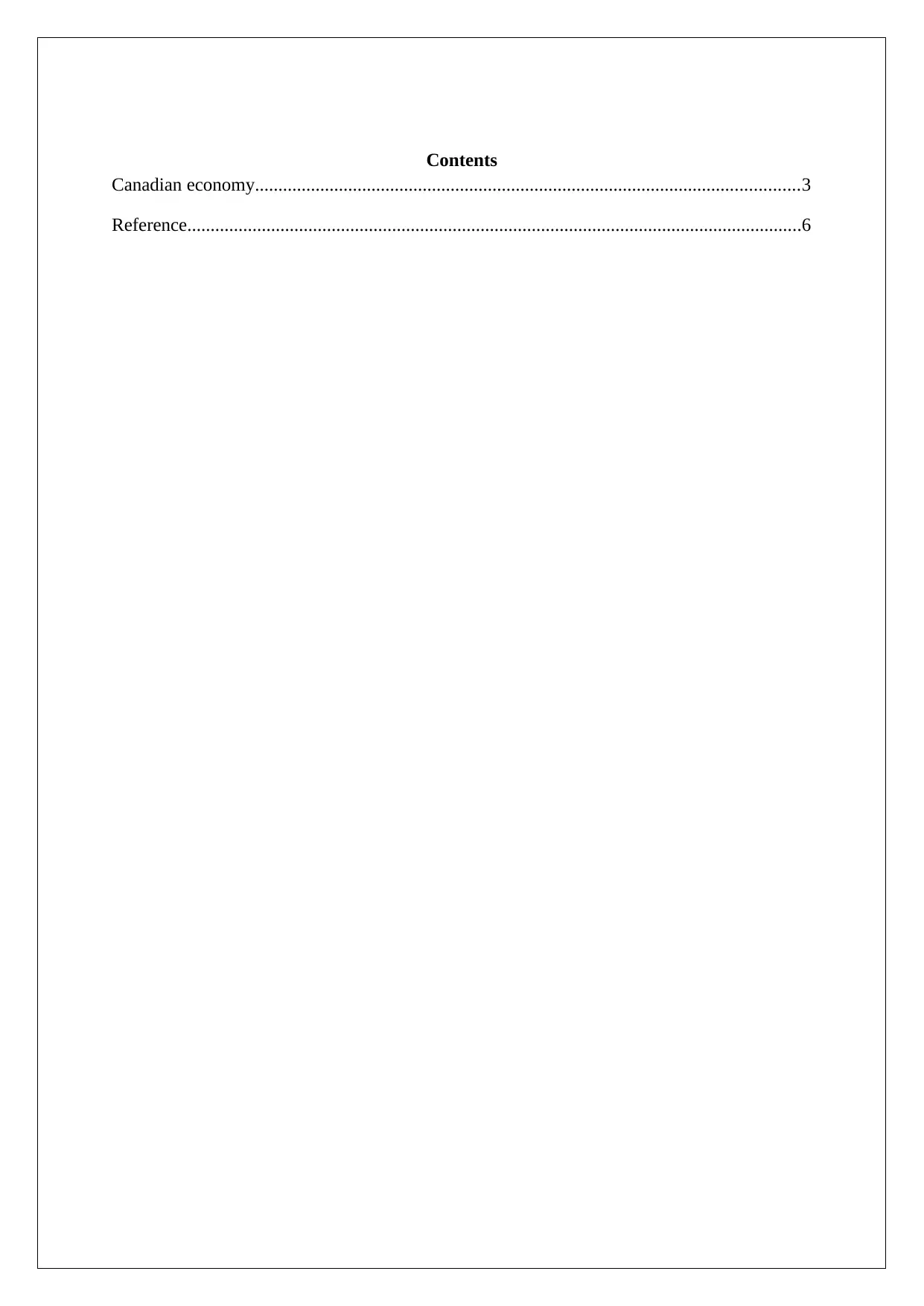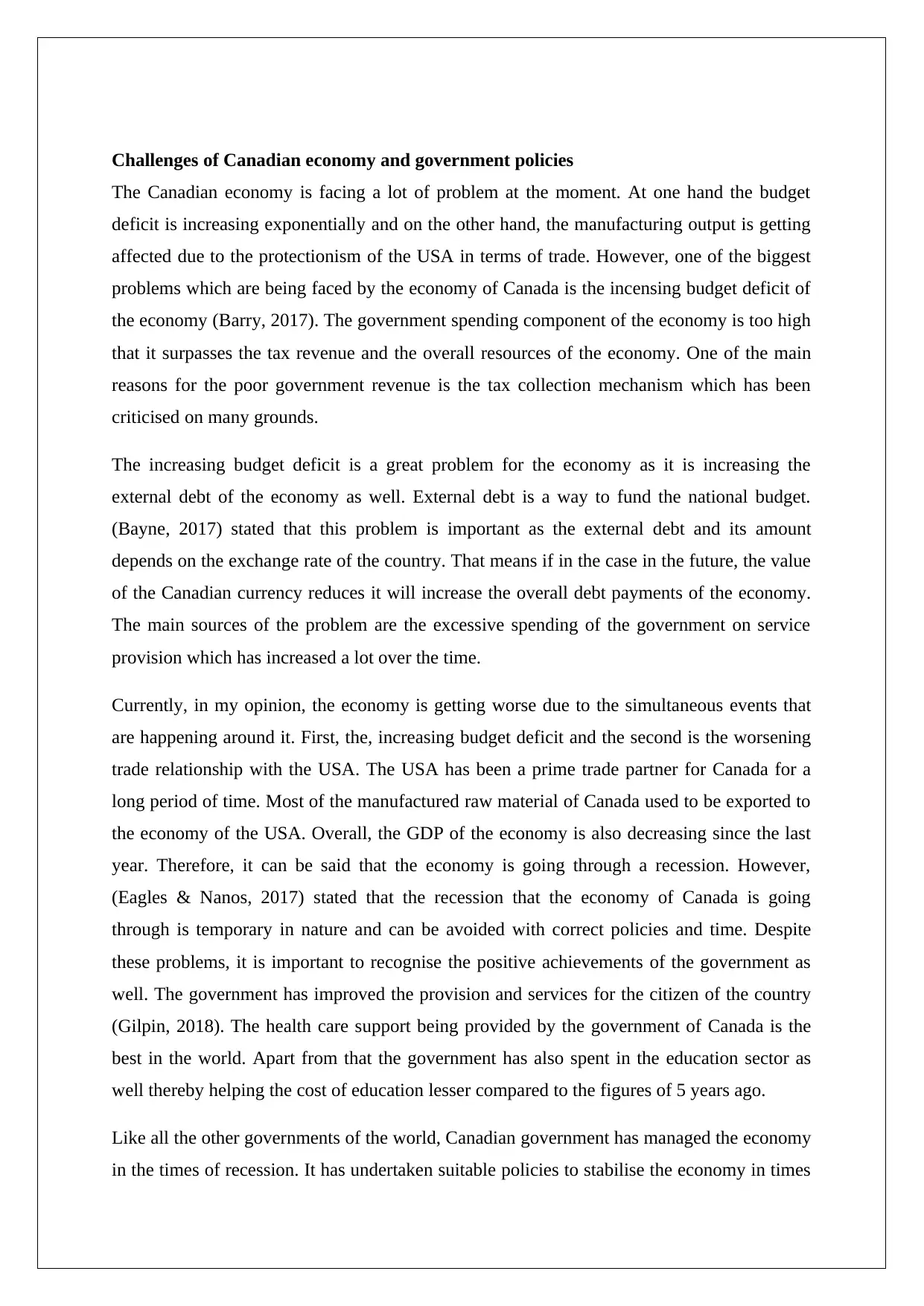Challenges Facing the Canadian Economy and Government Responses
VerifiedAdded on 2023/04/22
|6
|1465
|215
Essay
AI Summary
This essay examines the challenges confronting the Canadian economy, primarily focusing on the increasing budget deficit, strained trade relations with the USA, and a potential recession. It highlights the excessive government spending and a flawed tax collection mechanism as major contributors to the budget deficit, further exacerbated by potential currency devaluation impacting external debt. While acknowledging the government's positive contributions to healthcare and education, the essay critiques rising inflation and declining demand for key exports like steel and aluminum. It suggests measures to reduce government spending, lower interest rates to stimulate consumer spending, and diversify trade relationships. The author disagrees with the notion that Canada would benefit from being part of the USA, emphasizing the country's self-sufficiency, stable manufacturing sector, and balanced labor force, arguing that US intervention could negatively impact productivity. The essay concludes that Canada's current economic downturn is temporary and manageable with appropriate policies.

ECONOMICS ASSIGNMENT
Paraphrase This Document
Need a fresh take? Get an instant paraphrase of this document with our AI Paraphraser

Contents
Canadian economy.....................................................................................................................3
Reference....................................................................................................................................6
Canadian economy.....................................................................................................................3
Reference....................................................................................................................................6

Challenges of Canadian economy and government policies
The Canadian economy is facing a lot of problem at the moment. At one hand the budget
deficit is increasing exponentially and on the other hand, the manufacturing output is getting
affected due to the protectionism of the USA in terms of trade. However, one of the biggest
problems which are being faced by the economy of Canada is the incensing budget deficit of
the economy (Barry, 2017). The government spending component of the economy is too high
that it surpasses the tax revenue and the overall resources of the economy. One of the main
reasons for the poor government revenue is the tax collection mechanism which has been
criticised on many grounds.
The increasing budget deficit is a great problem for the economy as it is increasing the
external debt of the economy as well. External debt is a way to fund the national budget.
(Bayne, 2017) stated that this problem is important as the external debt and its amount
depends on the exchange rate of the country. That means if in the case in the future, the value
of the Canadian currency reduces it will increase the overall debt payments of the economy.
The main sources of the problem are the excessive spending of the government on service
provision which has increased a lot over the time.
Currently, in my opinion, the economy is getting worse due to the simultaneous events that
are happening around it. First, the, increasing budget deficit and the second is the worsening
trade relationship with the USA. The USA has been a prime trade partner for Canada for a
long period of time. Most of the manufactured raw material of Canada used to be exported to
the economy of the USA. Overall, the GDP of the economy is also decreasing since the last
year. Therefore, it can be said that the economy is going through a recession. However,
(Eagles & Nanos, 2017) stated that the recession that the economy of Canada is going
through is temporary in nature and can be avoided with correct policies and time. Despite
these problems, it is important to recognise the positive achievements of the government as
well. The government has improved the provision and services for the citizen of the country
(Gilpin, 2018). The health care support being provided by the government of Canada is the
best in the world. Apart from that the government has also spent in the education sector as
well thereby helping the cost of education lesser compared to the figures of 5 years ago.
Like all the other governments of the world, Canadian government has managed the economy
in the times of recession. It has undertaken suitable policies to stabilise the economy in times
The Canadian economy is facing a lot of problem at the moment. At one hand the budget
deficit is increasing exponentially and on the other hand, the manufacturing output is getting
affected due to the protectionism of the USA in terms of trade. However, one of the biggest
problems which are being faced by the economy of Canada is the incensing budget deficit of
the economy (Barry, 2017). The government spending component of the economy is too high
that it surpasses the tax revenue and the overall resources of the economy. One of the main
reasons for the poor government revenue is the tax collection mechanism which has been
criticised on many grounds.
The increasing budget deficit is a great problem for the economy as it is increasing the
external debt of the economy as well. External debt is a way to fund the national budget.
(Bayne, 2017) stated that this problem is important as the external debt and its amount
depends on the exchange rate of the country. That means if in the case in the future, the value
of the Canadian currency reduces it will increase the overall debt payments of the economy.
The main sources of the problem are the excessive spending of the government on service
provision which has increased a lot over the time.
Currently, in my opinion, the economy is getting worse due to the simultaneous events that
are happening around it. First, the, increasing budget deficit and the second is the worsening
trade relationship with the USA. The USA has been a prime trade partner for Canada for a
long period of time. Most of the manufactured raw material of Canada used to be exported to
the economy of the USA. Overall, the GDP of the economy is also decreasing since the last
year. Therefore, it can be said that the economy is going through a recession. However,
(Eagles & Nanos, 2017) stated that the recession that the economy of Canada is going
through is temporary in nature and can be avoided with correct policies and time. Despite
these problems, it is important to recognise the positive achievements of the government as
well. The government has improved the provision and services for the citizen of the country
(Gilpin, 2018). The health care support being provided by the government of Canada is the
best in the world. Apart from that the government has also spent in the education sector as
well thereby helping the cost of education lesser compared to the figures of 5 years ago.
Like all the other governments of the world, Canadian government has managed the economy
in the times of recession. It has undertaken suitable policies to stabilise the economy in times
⊘ This is a preview!⊘
Do you want full access?
Subscribe today to unlock all pages.

Trusted by 1+ million students worldwide

of problems. Therefore, it is important to say that people of the economy depend on the
government for decision making. One of the biggest problems faced by the Canadians is the
inflation that is increasing due to the budget deficit (Hübner, Deman & Balik, 2017). The
government is injecting money in the system and hence the inflation is increasing
exponentially. The prices of most of the goods and the services have increased over the years.
In addition to that, another problem faced by the government is the lack of demand for the
steel and the aluminium products which used to be exported to different countries of the
world. The manufacturing units present in different provinces of the country are facing an
excess production which needs to be managed by the government (Li, Wang & Whalley,
2017). Although the government has already reacted with buying the produces from the
manufacturing units in order to maintain stabilisation in the economy. The main challenge for
the central government of the country is to generate a high consumer spending so that import
substitution policies can be realised properly.
As the Finance Minister of Canada, I would reduce the government spending to reduce the
budget deficit of the economy. The budget deficit has reached an alarming stage where it can
harm and influence other sectors of the economy. The government of Canada has already
reached its goal in terms of infrastructure development and many of the sectors have enjoyed
gains over the years (Lilly, 2017). Now the objective of the government should be to channel
the production of the economy through the generation of consumer spending. The
government spending needs to be reduced, interest rates should be lowered that would, in
turn, increase the demand for the goods and services and the aggregate demand would
improve. Apart from that other trade relationships needs to be improved by the government
of Canada in order to have a high export in other parts of the world (Nevitte, 2017). An
excessive budget deficit could make the economy of Canada vulnerable to the changes in
other economies. The exchange rate is not in the hands of the government and a hence lower
value for the Canadian currency could increase the burden of the government.
I completely disagree with the statement provided in the question as the Canadian economy is
self-sufficient from all the aspects. The economy is going through a depression right now due
to some of the preferences of the government in the past which had its side effects on other
parts of the economy (Rugman & Verbeke, 2017). The country has a stable manufacturing
industry with ample low-cost labours and it also has a reasonable service sector. If it was a
part of the USA the manufacturing sector of the economy could have been affected due to the
government for decision making. One of the biggest problems faced by the Canadians is the
inflation that is increasing due to the budget deficit (Hübner, Deman & Balik, 2017). The
government is injecting money in the system and hence the inflation is increasing
exponentially. The prices of most of the goods and the services have increased over the years.
In addition to that, another problem faced by the government is the lack of demand for the
steel and the aluminium products which used to be exported to different countries of the
world. The manufacturing units present in different provinces of the country are facing an
excess production which needs to be managed by the government (Li, Wang & Whalley,
2017). Although the government has already reacted with buying the produces from the
manufacturing units in order to maintain stabilisation in the economy. The main challenge for
the central government of the country is to generate a high consumer spending so that import
substitution policies can be realised properly.
As the Finance Minister of Canada, I would reduce the government spending to reduce the
budget deficit of the economy. The budget deficit has reached an alarming stage where it can
harm and influence other sectors of the economy. The government of Canada has already
reached its goal in terms of infrastructure development and many of the sectors have enjoyed
gains over the years (Lilly, 2017). Now the objective of the government should be to channel
the production of the economy through the generation of consumer spending. The
government spending needs to be reduced, interest rates should be lowered that would, in
turn, increase the demand for the goods and services and the aggregate demand would
improve. Apart from that other trade relationships needs to be improved by the government
of Canada in order to have a high export in other parts of the world (Nevitte, 2017). An
excessive budget deficit could make the economy of Canada vulnerable to the changes in
other economies. The exchange rate is not in the hands of the government and a hence lower
value for the Canadian currency could increase the burden of the government.
I completely disagree with the statement provided in the question as the Canadian economy is
self-sufficient from all the aspects. The economy is going through a depression right now due
to some of the preferences of the government in the past which had its side effects on other
parts of the economy (Rugman & Verbeke, 2017). The country has a stable manufacturing
industry with ample low-cost labours and it also has a reasonable service sector. If it was a
part of the USA the manufacturing sector of the economy could have been affected due to the
Paraphrase This Document
Need a fresh take? Get an instant paraphrase of this document with our AI Paraphraser

historical national policies of the government. Another important asset the Canadian
economy has over the economy of USA is a mix of skilled and unskilled labour that can
maintain the balance between different sectors of the economy (Song, 2017). Intervention
from the side of the national government of USA would have had a detrimental effect on
productivity. Therefore, according to me, Canada is better off not being a part of the USA.
economy has over the economy of USA is a mix of skilled and unskilled labour that can
maintain the balance between different sectors of the economy (Song, 2017). Intervention
from the side of the national government of USA would have had a detrimental effect on
productivity. Therefore, according to me, Canada is better off not being a part of the USA.

Reference
Barry, D. (2017). Toward a Canada-EU partnership?. In Crossing the Atlantic (pp. 35-58).
Routledge.
Bayne, N. (2017). Current Challenges to Economic Diplomacy. In The New Economic
Diplomacy: Decision Making and Negotiation in International Economic
Relations,pp. 97-116
Eagles, M., & Nanos, N. (2017). Stronger Together? Support for Political Cooperation in
Canada and the United States, 2005–2016. PS: Political Science & Politics, 50(3),
735-740.
Gilpin, R. (2018). The challenge of global capitalism: The world economy in the 21st
century. Princeton University Press.
Hübner, K., Deman, A. S., & Balik, T. (2017). EU and trade policy-making: the contentious
case of CETA. Journal of European Integration, 39(7), 843-857.
Li, C., Wang, J., & Whalley, J. (2017). China’s regional and bilateral trade agreements.
In THE ECONOMIES OF CHINA AND INDIA Cooperation and Conflict: Volume 1:
China and India—The International Context and Economic Growth, Manufacturing
Performance and Rural Development,pp. 175-194
Lilly, M. B. (2017). How Demographic Transition Can Help Predict Canada-US Trade
Relations in 25 Years. International Journal of Canadian Studies, 55, 67-76.
Nevitte, N. (2017). The North American Trajectory: Cultural, Economic, and Political Ties
among the United States, Canada and Mexico. Routledge.
Rugman, A., & Verbeke, A. (2017). Global corporate strategy and trade policy. Routledge.
Song, G. (2017). A New Model of Major-Country Economic Relations between China and
the United States and Its Effects on the G20. In China and the Group 20: The
Interplay between a Rising Power and an Emerging Institution,pp. 247-263.
Barry, D. (2017). Toward a Canada-EU partnership?. In Crossing the Atlantic (pp. 35-58).
Routledge.
Bayne, N. (2017). Current Challenges to Economic Diplomacy. In The New Economic
Diplomacy: Decision Making and Negotiation in International Economic
Relations,pp. 97-116
Eagles, M., & Nanos, N. (2017). Stronger Together? Support for Political Cooperation in
Canada and the United States, 2005–2016. PS: Political Science & Politics, 50(3),
735-740.
Gilpin, R. (2018). The challenge of global capitalism: The world economy in the 21st
century. Princeton University Press.
Hübner, K., Deman, A. S., & Balik, T. (2017). EU and trade policy-making: the contentious
case of CETA. Journal of European Integration, 39(7), 843-857.
Li, C., Wang, J., & Whalley, J. (2017). China’s regional and bilateral trade agreements.
In THE ECONOMIES OF CHINA AND INDIA Cooperation and Conflict: Volume 1:
China and India—The International Context and Economic Growth, Manufacturing
Performance and Rural Development,pp. 175-194
Lilly, M. B. (2017). How Demographic Transition Can Help Predict Canada-US Trade
Relations in 25 Years. International Journal of Canadian Studies, 55, 67-76.
Nevitte, N. (2017). The North American Trajectory: Cultural, Economic, and Political Ties
among the United States, Canada and Mexico. Routledge.
Rugman, A., & Verbeke, A. (2017). Global corporate strategy and trade policy. Routledge.
Song, G. (2017). A New Model of Major-Country Economic Relations between China and
the United States and Its Effects on the G20. In China and the Group 20: The
Interplay between a Rising Power and an Emerging Institution,pp. 247-263.
⊘ This is a preview!⊘
Do you want full access?
Subscribe today to unlock all pages.

Trusted by 1+ million students worldwide
1 out of 6
Related Documents
Your All-in-One AI-Powered Toolkit for Academic Success.
+13062052269
info@desklib.com
Available 24*7 on WhatsApp / Email
![[object Object]](/_next/static/media/star-bottom.7253800d.svg)
Unlock your academic potential
Copyright © 2020–2025 A2Z Services. All Rights Reserved. Developed and managed by ZUCOL.





